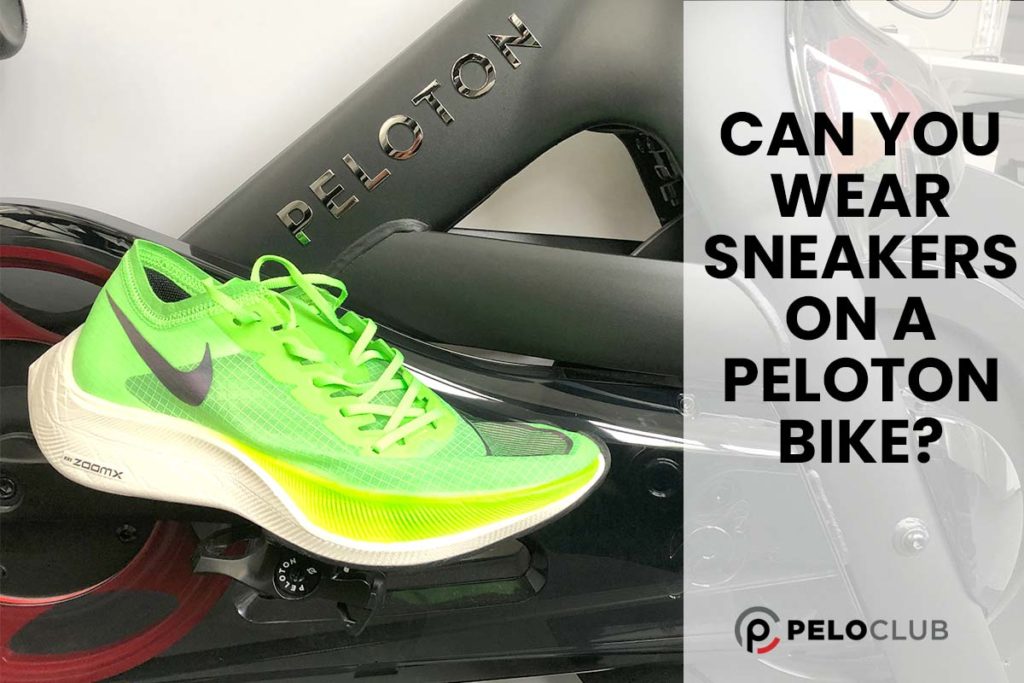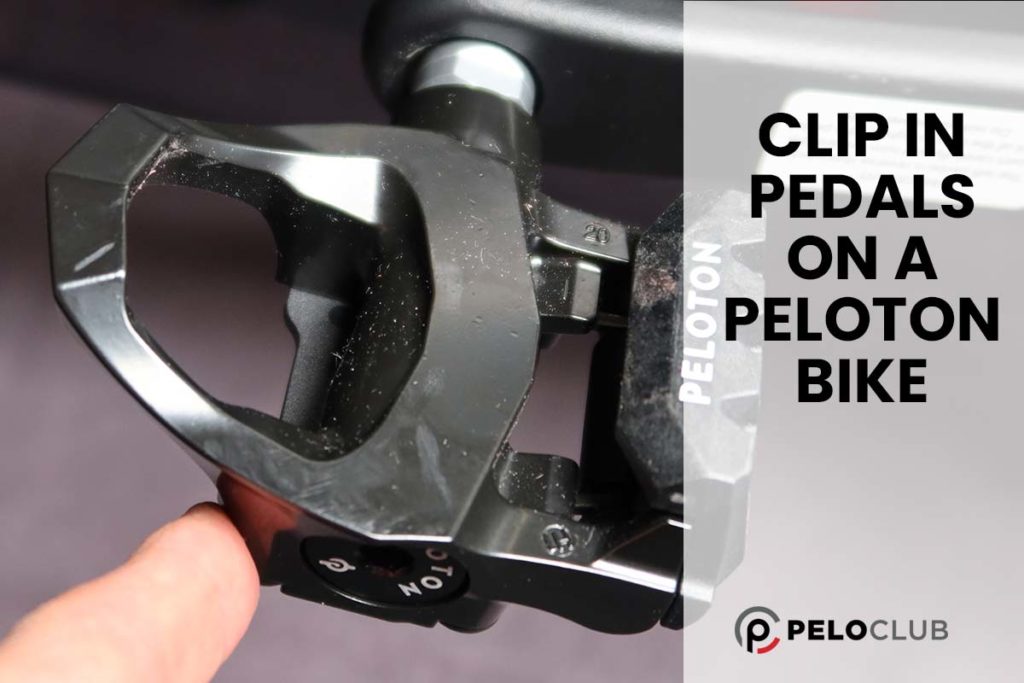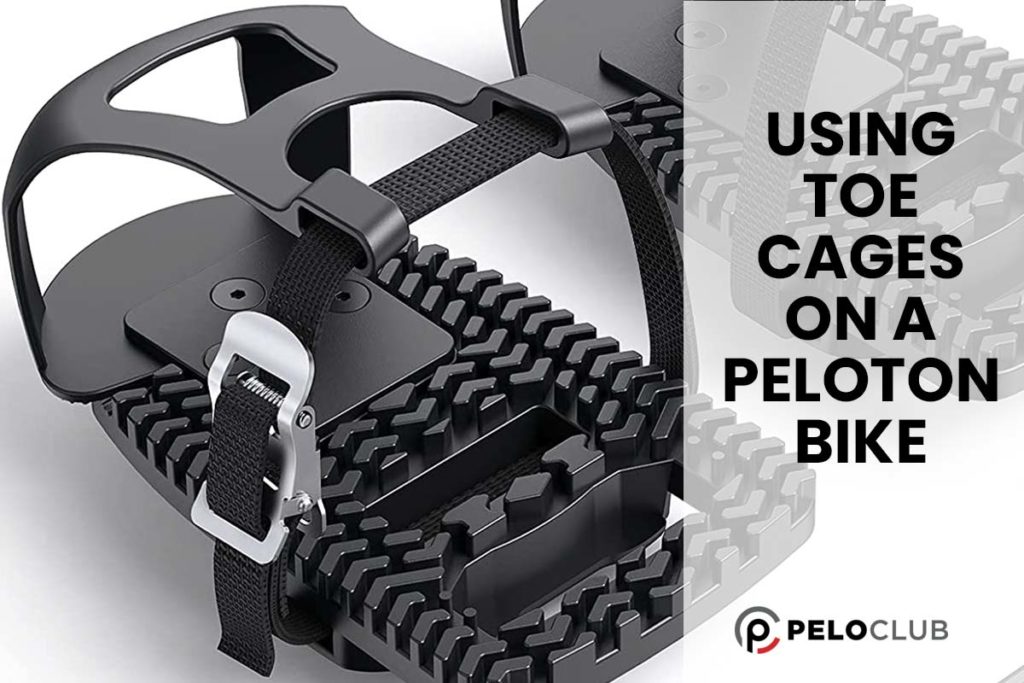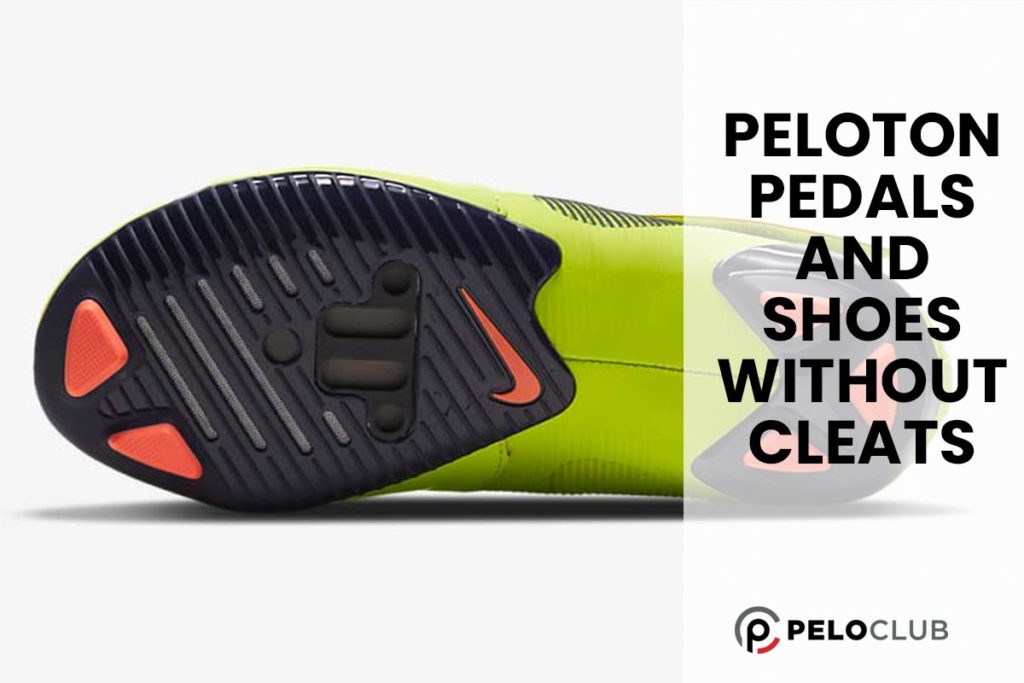
Are you thinking about riding your Peloton Bike or Bike+ with sneakers or training shoes? Is it safe? Is it a good idea? Will it be easier?
This is what you need to know before you decide if using sneakers or training shoes on your Peloton Bike is right for you:
Can You Wear Sneakers or Regular Training or Running Shoes on a Peloton Bike or Bike+? Yes, you can wear other shoes to ride your Peloton, but only if you add toe cages to the pedals that come with a Peloton Bike or Bike+, or change the pedals. As much as some people try to place their shoes on top of the pedals supplied or on the backside of the pedals, this is not safe.
Read on to discover more about how to safely ride using non-cycling shoes with your Peloton Bike or Bike+.
Table of Contents
- What Type of Pedals Does My Peloton Bike or Bike+ Come With?
- Pros and Cons of Clip-In Pedals on a Peloton Bike or Bike+
- Can You Attach a Toe Cage to a Peloton Bike or Bike+ Pedal?
- Can You Attach Pedals Without Cleats to a Peloton Bike or Bike+?
- Can You Use the Peloton Pedals with Shoes Without Cleats?
- What are the Best Shoes Without Cleats When Riding a Peloton Bike?
The Peloton Bike and Bike+ come with a specific type of clip-in pedal. Still, maybe you don’t have or want cycling shoes, or perhaps several people are using the Peloton, so wondered if you can use sneakers, gym, tennis, running, or other shoes that don’t have the correct pedal cleats.
What Type of Pedals Does My Peloton Bike or Bike+ Come With?
The Peloton comes with pedals that physically attach to shoes using a Delta-compatible cleat, also sometimes known as Look pedal cleats or 3-screw hole cleats.
These clip-in shoes are very common for road bikes, which is why they were the ideal choice for the Peloton Bike and Bike+. Still, not everybody, especially to start with, is confident being attached to their bike, even if it doesn’t go anywhere. The risk of falling off and staying attached is significantly reduced.
Pros and Cons of Clip-In Pedals on a Peloton Bike or Bike+
Pros
- Better pedal technique
- Correct foot position
- More secure and safer
- Improved power
- Less risk of injury
- Correct foot position
Cons
- Need specific shoes and everybody needs them
- Need to get used to clipping in and out
- Not easy to use off the bike (cleats stick out)
- Shoes not as comfortable
- Fear of being stuck

Advantages of Being Clipped in on Your Peloton Bike or Bike+
There are many advantages of being clipped into your Peloton Bike pedals. Even if you are worried, after just one or two rides, you’ll wonder why as, in my opinion, the benefits far outweigh any bad points.
Peloton recommends using the clip-in Delta pedals which the bike comes with, as these are the pedals the bike has been designed with. Therefore these pedals should help you perform well during your rides, as they are at least 10% more efficient, even for the best or most inexperienced cyclists.
Clipping in prevents your foot from moving on the Peloton bike pedal
When your cycling shoe is clipped into the pedal, you will not be able to move your foot around excessively – this will help you have a more efficient ride, as you won’t ever be focused on adjusting your feet.
Too many people connect with the pedal too far forward or backward on their foot, this is not only less powerful, but it’s also actually more likely to cause injury too.
You will be connected to your Peloton bike
Riding with clip-in shoes will allow you to connect with your bike. In addition, attaching yourself to the bike encourages smoother movements when riding.
You also don’t need to worry about falling off; it’s not like when you ride a regular bike and need to put your feet down from time to time.
You can pull up and push down your Peloton bike pedals with more power
As your foot is securely clipped in, your down pedals will be more effective as you do not shift your weight around or move your foot.
The balance provided by the clip-in cleats will give your ride more stability, and as a result, more energy will be channeled into your pedaling.
Your upstrokes on the pedals will also be more effective because you will be activating your hamstrings and glutes to pull the pedals up.
Without clip-in shoes, you won’t be able to pull up the pedals as easily or efficiently, so clip-ins allow your muscles to do this extra work and, therefore, increase the power in your ride.
Another benefit of this correct form is better muscle symmetry as the whole leg works the way it should, not focusing on or being biased towards a specific muscle group.
Reduced Risk of Injury While Riding Your Peloton Bike
Although you are securely attached to the bike, there is a slight lateral movement in the pedals.
This slight movement helps your natural biomechanics and, combined with the correct bike setup, which Peloton guides you through, minimizes the chance of injury through a mistake while riding and also through the cycling action too, even if you’re new to this.
Disadvantages of Being Clipped in on Your Peloton Bike or Bike+
Some people don’t like the feeling of clip-in shoes, as they want to have more freedom to move their feet while riding, so being restricted by clipped in shoes may be seen as a disadvantage.
It is also possible that you like to do exercise sessions during which you switch from riding your Peloton Bike to doing other workout exercises, such as weight training or plyometrics.
In this case, having to take off your clip-in shoes and switch to trainers during a session might be an inconvenience.

Can You Attach a Toe Cage to a Peloton Bike or Bike+ Pedal?
Yes, you can. Instead of clipping cleats attached to cycling shoes onto your Peloton Bike pedals, you’re able to attach what’s called a toe cage, or sometimes a toe clip pedal adapter.
Attaching a toe cage will allow you to use your Peloton with virtually any type of shoe and make it safe too.
Toe cages mean you can still enjoy a safe and powerful ride, even if you give up the last 10% of ultimate performance.
Some toe cages can be attached directly onto the Delta pedals that your Peloton Bike came with. It’s quick, easy to do, and 100% reversible if and when you decide to start using cycling shoes or if you have cycling shoes, but maybe other users don’t.
If you do decide to use a toe cage, they’re available from Peloton, but Amazon has a wide choice too. What I’d suggest is that you should get a toe cage that has a complete cage covering the toe and top of the shoe and a quick adjustable strap, too, for easy entry and exit. Here’s an excellent example with an ideal sole area for grip.
Some people think a flat pedal with a strap is OK, more like the stationary exercise bikes you find at a gym, but to get the best out of your Peloton Bike or Bike+, they’re not a good idea.
Another option, that’s also low cost, is just using a pedal plate or platform adaptor; this clips into the supplied pedals and makes them flat; this is an example of this, and as you’ll see, they are not expensive. But to me, a toe cage is a better option.
Can You Attach Pedals Without Cleats to a Peloton Bike or Bike+?
Yes, you can use other pedals with your Peloton. Installing other pedals will not void your Peloton warranty either.
You can remove the Delta pedals that your Peloton Bike comes with and replace them with other types of pedals. This might be useful if you feel that the Delta pedals are not working for you.
The pedals you want to attach to your Peloton Bike must be compatible with a 9/16″ (15mm) screw size, as this is the size of the Peloton’s pedal connection.
If you decide to change the supplied Peloton pedals for flat ones, you need to ensure they have enough grip.
There’s no need to go for a pedal designed for mountain bikes, that has the extra grip to help when it’s wet or muddy, as this isn’t an issue.
This is a good pedal option to look at for guidance.
An option here is to buy multi-use pedals where one side uses a flat design, and the other uses a clip in the pedal, usually, the SPD type, as this can be a good option, especially if you have shoes using an SPD cleat or somebody who rides the Peloton that does.
Again, having a toe cage is helpful, and some pedals come with these, or you can also buy an add-on toe cage.
You can use flat pedals without a toe cage or even a strap, but it’s not what I’d suggest you do, unless you are worried about being connected, even in an easy-to-remove physical way, to your Peloton Bike or Bike+.
Can You Use the Peloton Pedals with Shoes Without Cleats?

No, unless you want to risk injury. Clip-in pedals were never designed to be used with trainers or other shoes.
It’s not good safe, or sensible to ride your Peloton Bike with Delta, or other clip-in pedals like SPD, Eggbeater, Time, or Speedplay pedals while wearing shoes that don’t use the right cleats, even if they are cycling shoes.
Using cleats and clip-in cycling shoes is the recommended way to get the most out of riding your Peloton Bike, and Delta pedals are excellent, based on the three connection points.
The clip-in pedals on your Peloton Bike are smaller than regular flat pedals, meaning they will not be easy or safe to use with training shoes. The pedals also don’t have enough grip to be effective.
However, some riders prefer wearing regular sneakers as it feels more flexible during the ride instead of being clipped in.
What are the Best Shoes Without Cleats When Riding a Peloton Bike?
There are all sorts of options to choose from when it comes to using your Peloton with other shoes. But as a general rule, they should be a good fit, secure and if they use laces, the laces should be kept out of the way of the pedals.
The Peloton Bike and Bike+ doesn’t use a chain like a standard bike, and the belt drive is covered. However, the pedals still rotate, so an undone shoelace can quickly become caught up.
Cycling shoes
Cycling shoes are a type of shoe specifically for the purpose, and there are various types for cycling, from downhill mountain biking to indoor spin classes, but all can work on the Peloton with the right changes made.
In general, cycling shoes are designed to allow you to enjoy a more efficient cycling experience, and, in some cases, they work without cleats, if you have toe cages or flat pedals.
Cycling shoes tend to have a stiffer sole to transfer power through the foot to the pedal efficiently. Most also have a more rigid structure too that also helps cycling efficiency.
Some cycle shoes even have the option to add cleats later if you want, but they usually use a different type of cleat for what’s called an SPD pedal, which is different from what’s supplied with the Peloton Bike and Bike+.
If you do use cycling shoes without cleats, make sure the shoe’s sole has some grip. Otherwise, it will not be safe; this is an example of this type of shoe from a company called TIEM, or these by a company called Tommaso; both companies have perfect quality cycle shoes.
Sneakers, Trainers, and Running Shoes
First of all, remember that you’ll need a toe cage, strap, or platform if you’re using regular trainers on your Peloton.
If you do opt to ride in some form of a training shoe, instead of cycling shoes, those with a stiffer sole, good grip to help prevent your foot from moving in the pedals, and a breathable fabric will be best for riding your Peloton.
So now you know the safe and best way to use other shoes on your Peloton Bike or Bike+.
I hope you’ve found this helpful, and don’t forget to send me a “High Five” if you see me on the leaderboard.
